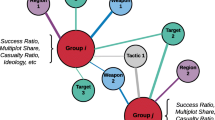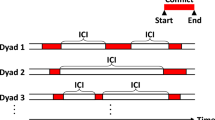Abstract
Tactical decisions made by jihadist groups can have extremely negative impacts on societies. Studying the characteristics of their attacks over time is therefore crucial to extract relevant knowledge on their operational choices. In light of this, the present study employs transition networks to construct trails and analyze the behavioral patterns of the world’s five most active jihadist groups using open access data on terror attacks from 2001 to 2016. Within this frame, we propose Normalized Transition Similarity (NTS), a coefficient that captures groups’ pairwise similarity in terms of transitions between different temporally ordered sequences of states. For each group, these states respectively map attacked targets, employed weapons, and targets and weapons combined together with respect to the entire sequence of attacks. Analyses show a degree of stability of results among a number of pairs of groups across all trails. With this regard, Al Qaeda and Al Shabaab exhibit the highest NTS scores, while the Taliban and Al Qaeda prove to be the most different groups overall. Finally, potential policy implications and future work directions are also discussed.






Similar content being viewed by others
Notes
We have created a single “Al Qaeda” group category summing together all the events plotted by the following factions present in the dataset, which are part of the greater Al Qaeda network: Al-Qaida, Al-Qaida in Iraq, Al-Qaida in Saudi Arabia, Al-Qaida in the Arabian Peninsula (AQAP), Al-Qaida in Yemen, Al Qaida in Lebanon, Al-Qaida in the Islamic Maghreb, Al-Qaida in the Indian Subcontinent, Islambouli Brigades of Al-Qaida, Secret Organization of Al-Qaida in Europe, Al-Qaida Organization for Jihad in Sweden, Al-Qaida Network for Southwestern Khulna Division, Jadid Al-Qaida Banglades (JAQB), Al-Qaida Kurdish Battalions.
It is worth specifying that in the analyses, events will be ordered temporally but without taking into account the actual delta between attacks. This means that there is no difference between two attacks plotted within a range of 4 days and the other two attacks plotted within a range of 5 months. Additionally, when two or more attacks are plotted on the same day, we order them by the eventid variable included in the original dataset, assuming that the information coded in the variable provides a more robust ordering criterion than pure random distribution.
References
Abubakar, D. (2017). From sectarianism to terrorism in Northern Nigeria: A closer look at Boko Haram. Violent Non-State Actors in Africa (pp. 17–47). Cham: Palgrave Macmillan.
Akinola, O. (2015). Boko Haram Insurgency in Nigeria: Between islamic fundamentalism, politics, and poverty. African Security, 8(1), 1–29.
Asal, V. H., Karl Rethemeyer, R., Anderson, I., Stein, A., Rizzo, J., & Rozea, M. (2009). The softest of targets: A study on terrorist target selection. Journal of Applied Security Research, 4(3), 258–278.
Bier, V., Oliveros, S., & Samuelson, L. (2007). Choosing what to protect: Strategic defensive allocation against an unknown attacker. Journal of Public Economic Theory, 9(4), 563–587.
Brandt, P. T., & Sandler, T. (2010). What do transnational terrorists target? Has it changed? Are we safer? Journal of Conflict Resolution, 54(2), 214–236.
Byman, D. (2014). Buddies or burdens? Understanding the Al Qaeda relationship with its affiliate organizations. Security Studies, 23(3), 431–470.
Carley, K. M. (2014). ORA: A toolkit for dynamic network analysis and visualization. In R. Alhajj & J. Rokne (Eds.), Encyclopedia of social network analysis and mining (pp. 1219–1228). New York: Springer.
Clauset, A., Young, M., & Gleditsch, K. S. (2007). On the frequency of severe terrorist events. Journal of Conflict Resolution, 51(1), 58–87.
Cronin, A. K. (2015). ISIS is not a terrorist group: Why counterterrorism won’t stop the latest Jihadist Threat. Foreign Affairs, 94, 87.
Drake, C. J. M. (1998). Terrorists’ target selection. New York: St. Martin’s Press. OCLC: 759111922.
Farwell, J. P. (2014). The media strategy of ISIS. Survival, 56(6), 49–55.
Global Terrorism Database (Data file). (2016). National consortium for the study of terrorism and responses to terrorism.
Genkin, M., & Gutfraind, A. (2011). How do terrorist cells self-assemble: Insights from an agent-based model of radicalization. SSRN Electronic Journal.
Gerdes, L. M. (2015). Illuminating dark networks: The study of Clandestine Groups and Organizations. Cambridge: Cambridge University Press.
Hansen, S. J. (2013). Al-Shabaab in Somalia: The history and ideology of a Militant Islamist Group. Oxford: Oxford University Press.
Holbrook, D. (2015). Al-Qaeda and the rise of ISIS. Survival, 57(2), 93–104.
Institute for Economics and Peace. (2016). Global terrorism index report. Technical report, Institute for Economics and Peace.
Institute for Economics and Peace. (2017). Global terrorism index report. Technical report, Institute for Economics and Peace.
Iyekekpolo, W. O. (2016). Boko Haram: Understanding the context. Third World Quarterly, 37(12), 2211–2228.
Jabareen, Y. (2015). The emerging Islamic State: Terror, territoriality, and the agenda of social transformation. Geoforum, 58, 51–55.
Johnson, T. H. (2013). Taliban adaptations and innovations. Small Wars and Insurgencies, 24(1), 3–27.
Joosse, P., Bucerius, S. M., & Thompson, S. K. (2015). Narratives and counternarratives: Somali-Canadians on recruitment as foreign fighters to Al-Shabaab. British Journal of Criminology, 55(4), 811–832.
Keller, J. P., Desouza, K. C., & Lin, Y. (2010). Dismantling terrorist networks: Evaluating strategic options using agent-based modeling. Technological Forecasting and Social Change, 77(7), 1014–1036.
Klausen, J. (2015). Tweeting the Jihad: Social media networks of western foreign fighters in Syria and Iraq. Studies in Conflict and Terrorism, 38(1), 1–22.
Kleiner, J. (2000). The Taliban and Islam. Diplomacy and Statecraft, 11(1), 19–32.
Krebs, V. (2002). Mapping networks of terrorist cells. Connections, 24(3), 43–52.
LaFree, G. (2010). The global terrorism database: Accomplishments and challenges. Perspectives on Terrorism, 4, 1.
LaFree, G., & Dugan, L. (2007). Introducing the global terrorism database. Terrorism and Political Violence, 19(2), 181–204.
Lee, Deokjae, Goh, K.-I., Kahng, B., & Kim, D. (2010). Complete trails of coauthorship network evolution. Physical Review E, 82, 2.
Lind, J., Mutahi, P., & Oosterom, M. (2017). ‘Killing a mosquito with a hammer’: Al-Shabaab violence and state security responses in Kenya. Peacebuilding, 5(2), 118–135.
Loimeier, R. (2012). Boko Haram: The development of a Militant Religious Movement in Nigeria. Africa Spectrum, 47(2/3), 137–155.
Lopes, A. M., Tenreiro Machado, J. A., & Mata, M. E. (2016). Analysis of global terrorism dynamics by means of entropy and state space portrait. Nonlinear Dynamics, 85(3), 1547–1560.
Mahood, S., & Rane, H. (2017). Islamist narratives in ISIS recruitment propaganda. The Journal of International Communication, 23(1), 15–35.
Merrill, J. A., Sheehan, B. M., Carley, K. M., & Stetson, P. D. (2015). Transition networks in a cohort of patients with congestive heart failure: A novel application of informatics methods to inform care coordination. Applied Clinical Informatics, 06(03), 548–564.
Mueller, J. C. (2018). The evolution of political violence: The case of Somalia’s Al-Shabaab. Terrorism and Political Violence, 30(1), 116–141.
Onuoha, F. C. (2010). The Islamist challenge: Nigeria’s Boko Haram crisis explained. African Security Review, 19(2), 54–67.
Overgaard, P. B. (1994). The scale of terrorist attacks as a signal of resources. The Journal of Conflict Resolution, 38(3), 452–478.
Perliger, A., & Pedahzur, A. (2011). Social network analysis in the study of terrorism and political violence. Political Science and Politics, 44(1), 45–50.
Piazza, J. A. (2012). The opium trade and patterns of terrorism in the Provinces of Afghanistan: An empirical analysis. Terrorism and Political Violence, 24(2), 213–234.
Regens, J. L., Mould, N., Vernon, E., & Montgomery, A. (2016). Operational dynamics of Boko Haram’s terrorist campaign following leadership succession. Social Science Quarterly, 97(1), 44–52.
Sageman, M. (2014). The stagnation in terrorism research. Terrorism and Political Violence, 26(4), 565–580.
Sandler, T., & Lapan, H. E. (1988). The calculus of dissent: An analysis of terrorists’ choice of targets. Synthese, 76(2), 245–261.
Santifort, C., Sandler, T., & Brandt, P. T. (2013). Terrorist attack and target diversity: Changepoints and their drivers. Journal of Peace Research, 50(1), 75–90.
START. (2017). GTD Codebook: Inclusion criteria and variables. Technical report, University of Maryland.
Stergiou, D. (2016). ISIS political economy: Financing a terror state. Journal of Money Laundering Control London, 19(2), 189–207.
Tench, S., Fry, H., & Gill, P. (2016). Spatio-temporal patterns of IED usage by the Provisional Irish Republican Army. European Journal of Applied Mathematics, 27(03), 377–402.
Thruelsen, P. D. (2010). The Taliban in southern Afghanistan: A localised insurgency with a local objective. Small Wars and Insurgencies, 21(2), 259–276.
Vittori, K., Talbot, G., Gautrais, J., Fourcassié, V., Araújo, A. F. R., & Theraulaz, G. (2006). Path efficiency of ant foraging trails in an artificial network. Journal of Theoretical Biology, 239(4), 507–515.
Weeraratne, S. (2017). Theorizing the expansion of the Boko Haram insurgency in Nigeria. Terrorism and Political Violence, 29(4), 610–634.
Wilkinson, P. (1990). Terrorist targets and tactics: new risks to world order. Research Institute for the Study of Conflict and Terrorism.
Young, J. K., & Findley, M. G. (2011). Promise and Pitfalls of terrorism research. International Studies Review, 13(3), 411–431.
Zehr, N. A. (2017). The war against Al-Qaeda: Religion, Policy, and counter-narratives. Georgetown: Georgetown University Press.
Acknowledgements
The authors would like to thank the two anonymous reviewers for their comments on a previous version of the paper. This work was supported in part by the Office of Naval Research under the Multidisciplinary University Research Initiatives (MURI) Program award number N000141712675, Near Real Time Assessment of Emergent Complex Systems of Confederates, the Minerva program under grant number N000141512797, Dynamic Statistical Network Informatics, and by the center for Computational Analysis of Social and Organizational Systems (CASOS). The views and conclusions contained in this document are those of the authors and should not be interpreted as representing the official policies, either expressed or implied, of the ONR or the US government.
Author information
Authors and Affiliations
Corresponding author
Ethics declarations
Conflict of interest
On behalf of all authors, the corresponding author states that there is no conflict of interest.
Additional information
Publisher's Note
Springer Nature remains neutral with regard to jurisdictional claims in published maps and institutional affiliations.
Rights and permissions
About this article
Cite this article
Campedelli, G.M., Bartulovic, M. & Carley, K.M. Pairwise similarity of jihadist groups in target and weapon transitions. J Comput Soc Sc 2, 245–270 (2019). https://doi.org/10.1007/s42001-019-00046-8
Received:
Accepted:
Published:
Issue Date:
DOI: https://doi.org/10.1007/s42001-019-00046-8




